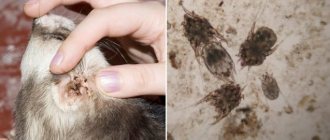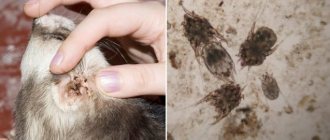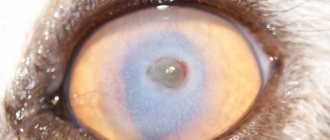Author:
Savina Elizaveta Sergeevna
therapist, surgeon, dermatologist, work with small rodents and rabbits
Ear mites (Otodectosis) are a problem not only for homeless and street animals, but also for completely healthy pets. Most cat owners experience this disease, but this disease is by no means uncommon in dogs. The consequence of this pathology is otitis media in animals.
Few people know how to treat it, much less how to detect it. Often, owners think that the animal has simply dirty its ears, since, apart from constant itching, this disease has no more characteristic and noticeable symptoms, and increased secretion of wax is mistaken for ordinary dirt.
Symptoms
Itching
. This is the main and very characteristic sign of tick-borne infestation. It occurs as an allergic reaction to the saliva and feces of the mite. At the very beginning of the disease, the itching is mild, but intensifies over time. Cats and dogs often begin to scratch their ears with their hind paws and shake their ears. With further development of the disease, the symptoms of inflammation intensify, hyperemia (redness), swelling and exudate are noted. The pet does not allow his ears to be touched, he is worried.
Discharge from the ear canal
. The typical appearance of discharge from otodectosis is dark brown crusts covering the inner surface of the auricle, which often clog the external auditory canal. At the beginning of the disease, a clear serous exudate is released from the ear, which can later become purulent and have a strong, unpleasant odor.
When scratching the ears with claws, purulent microflora quickly develops in the wounds. In such a situation, they no longer talk about ear scabies, but about a mixed infection, parasitic otitis media.
This disease is characterized by discharge of a syrupy consistency, often very copious. When a large amount of exudate accumulates in one ear, the animal often tilts its head to the affected side. In severe cases, such a dangerous complication as perforation of the eardrum is possible. The animal refuses to eat and a fever appears. If the inflammation spreads to the middle ear and the lining of the brain, a convulsive syndrome develops. This complication of otitis media can be fatal.
Other symptoms of otodectosis may also include alopecia (hair loss), pain sensitivity in the jaw and ears.
What kind of disease is this?
Otodectosis has other names - parasitic otitis media, ear mites, ear scabies. In fact, this is all a disease of the outer ear, which is provoked by microscopic parasites called Otodectes Cynotis.
As a rule, one ear is affected first, after which the disease spreads to the second. Also, parasites sometimes move to other parts of the animal’s body - neck, tail, pelvic area. This happens when the animal sleeps, curled up in a ball. People who do not understand the features of this disease may confuse it with dermatitis, allergies or traces of flea bites.
When the cat is kept in good conditions, fed properly and its ears are cleaned regularly, otodectosis can be asymptomatic and go unnoticed. If conditions worsen or against the background of an unbalanced diet, ticks quickly enter the active phase. In young cats and kittens, the disease is always more severe.
Treatment
Mechanical cleaning.
Before starting treatment (after the doctor has made a diagnosis), it is necessary to clean the ears as much as possible from dried crusts, exudate and the mites themselves. For this purpose, you can use a 3% solution of hydrogen peroxide, but the hissing and heating sensation in the ear frightens the animal. If there is even the slightest suspicion of a perforated eardrum, you should immediately consult a specialist.
Special lotions soften the crusts well, facilitating the removal of exudate from the ear canal. Universal products such as Bars lotion are suitable for both cats and dogs. It is not advisable to use cotton swabs for cleaning, since there are often cases when the cotton swab slips off and remains in the ear canal. In addition, there is a risk of injury to the ears, because even the most obedient pet will not be able to lie still during cleaning.
How to clean?
To carefully clean your ears, you need to take a special lotion and a cotton pad. It is first recommended to shake the bottle a little and warm it in your hands so that the drops do not cause severe discomfort to the animal. The lotion is instilled into each ear, after which the auricle is massaged at the base, not allowing the animal to shake its head or shake its ears. Next, use the tip of a folded cotton pad to clean each fold of the auricle and, if possible, the ear canal.
Destruction of ticks
. After mechanical cleaning, special drops (“Bars”) are instilled into the ears or ointment (gel) is applied. It is better to warm up medications before administration. Both ears should be treated with drugs, even if there are no obvious signs of invasion in the second. Be careful! Drops against ticks should be applied strictly according to the instructions. As a rule, this is only two or three times with an interval of several days. Otitis drops are applied daily.
For aggressive cats and dogs, a different scheme is often used: an antiparasitic drug is applied to the skin in the withers area twice with an interval of 2 weeks, then once a month. This is especially convenient for owners who cannot instill acaricidal drops, although it is still recommended to clean the ears with hygienic lotion to speed up the healing process.
Focal and extrafocal forms of scabies spread
The scabies mite that causes the disease can be transmitted from a sick person to a healthy person through various types of contact: through direct (family or sexual) contact or indirectly through shared objects (clothing, bedding, shower accessories).
Doctors warn that scabies is an extremely contagious (contagious) disease and is more common than other parasitic skin diseases.
About 300 million cases of scabies are registered annually; the density of the disease is especially high in countries with a low level of hygienic culture of the population. An increase in diseases is recorded during wars, social and natural shocks, and economic downturns. At the same time, outbreaks of scabies are observed in relatively prosperous countries when the living conditions of certain social groups deteriorate.
Today, scabies is such a common disease in Russia that we can talk about an epidemic. This is facilitated by hotbeds of military action in various regions of the country and neighboring states, an increase in the number of migrants from Central Asian countries, including illegal ones, an increase in the number of people without a fixed place of residence, street children, and socially vulnerable citizens.
It should be noted that the spread of scabies is also facilitated by the development of crime, an increase in the number of people who drink alcohol and drugs, and practice promiscuous sexual relations.
In modern Russia, there is a weakening of the immune system in the vast majority of residents, which also affects the progressive spread of scabies. There are experts who believe that there is a connection between periods of increased solar activity and an increase in the number of cases of scabies.
These factors contribute to the creation of spontaneous foci of the disease. The focus of scabies can be considered a group of people in which there is a patient who can infect others. A focus in which there is only one infected person is considered potential, and if there are two or more patients in the group, then such a focus is classified as a radiating or active focus of scabies.
Infection with scabies mites most often occurs within a family, where the mite was brought by one of the family members - this is the most common route of transmission of scabies and is recorded in 90% of registered cases. In such cases, medical workers identify a family outbreak of scabies infection. Somewhat less common are cases of infection of relatives or acquaintances who are not constantly in the family, which is a hotbed of scabies.
Half of the people who are the primary sources of family scabies infection are in the age group of 17–35 years. In a family, most often these are children of different ages, husbands. Infection occurs both sexually and through common objects. Within a family, one spouse infects the other, children can become infected through household means (the indirect route of infection is no more than 13%).
Experts identify another possible way for scabies to spread—foci of infection in organized communities. There are invasive contagious organized groups - those in which the conditions for transmission of the scabies pathogen are similar to the family focus, and groups in which such conditions are absent.
- The first group is groups that have common places of residence and recreation (bedrooms in orphanages, camps, boarding schools, dormitories). Pseudo-irrigation is often recorded - two (or more) sick people may appear in one outbreak, who became infected from different sources of the spread of the disease (independent of each other).
- The second group is non-invasive contact groups. This is the name given to teams whose members live or are located within the same building, and their contacts occur during the daytime. These are groups in kindergartens, classes in schools, groups in secondary and higher educational institutions, various labor collectives of enterprises and organizations. These groups do not pose a threat of epidemic spread; scabies manifests itself as a separate case of the disease.
Along with focal ones, there are also extrafocal forms of scabies mite spread. The pathogen is transmitted in such cases in a bath or sauna, on long-distance trains, and hotels. Such cases of tick transmission are recorded quite rarely.
Scabies is more common in the younger population. College students, vocational schools, and universities hold first place in the frequency of scabies infection. Young men can become infected through sexual contact, or while staying in a collective outbreak (the outbreak can be military training, internship, or in a dormitory). Second place is occupied by teenagers and children of secondary school age - they are also at high risk of infection, in third place are younger schoolchildren who became infected within the family or in preschool institutions. Persons over 26 years of age rank last in terms of the number of diseases and the intensity of the spread of scabies.
Prevention of otodectosis
- Avoid contact with stray animals.
- Hygienic cleaning of ears if necessary.
- Preventive treatment with insectoacaricides against ticks throughout the warm season.
- Timely contact a veterinarian if signs of itching in the auricle appear for differential diagnosis of ear scabies and early treatment.
The prognosis of the disease largely depends on when treatment was started. It is important not to interrupt the course of treatment prescribed by the doctor if the symptoms disappear. This prevents the disease from becoming chronic.
It is useful from childhood to accustom four-legged pets to simple manipulations - trimming their nails, examining the oral cavity and cleaning their ears. Manifestations of aggression during ear treatments make treatment very difficult, especially when it comes to cats.
Diagnostics
The diagnosis of Otodectosis is made based on clinical symptoms and microscopic examination of the contents of the ear canal.
Veterinary dermatologist Goncharova A.E. conducts a microscopic examination of a smear
How to detect ear mites on a cat or dog?
This parasite is very small in size and is usually difficult to see with the naked eye. Sometimes you can notice very small moving white dots in the ear. Often, owners notice that the pet is bothered by the desire to scratch its ears, especially when touched. The pet often shakes its head, and in the ear canals you may notice the presence of dark brown (the color of black coffee), dry, crumbly or thick, like ointment, discharge. If there are many of them, they can block the ear canal and lead to partial or complete hearing loss in the pet.










